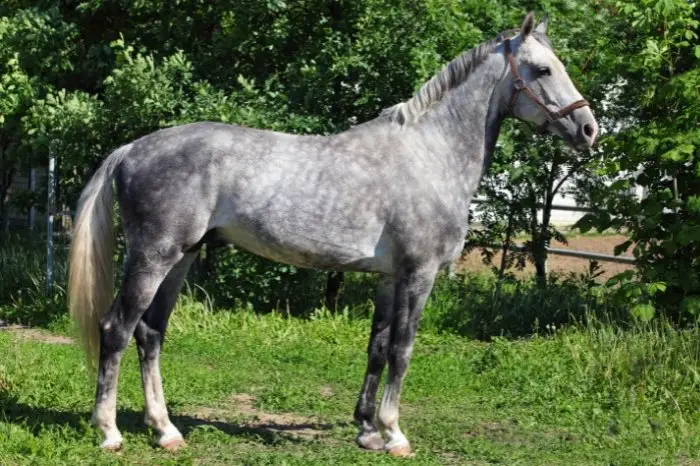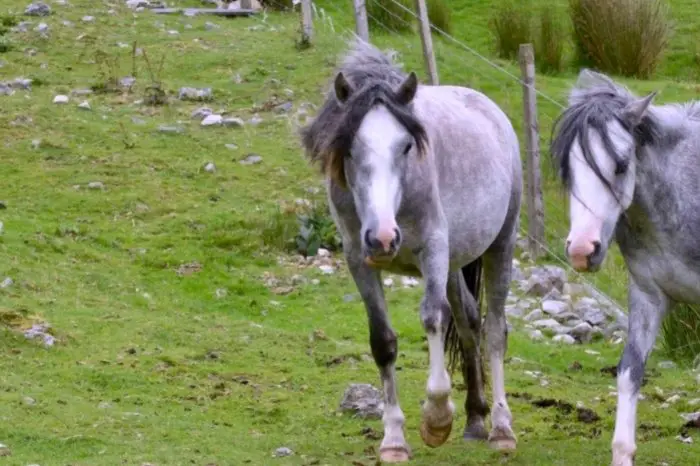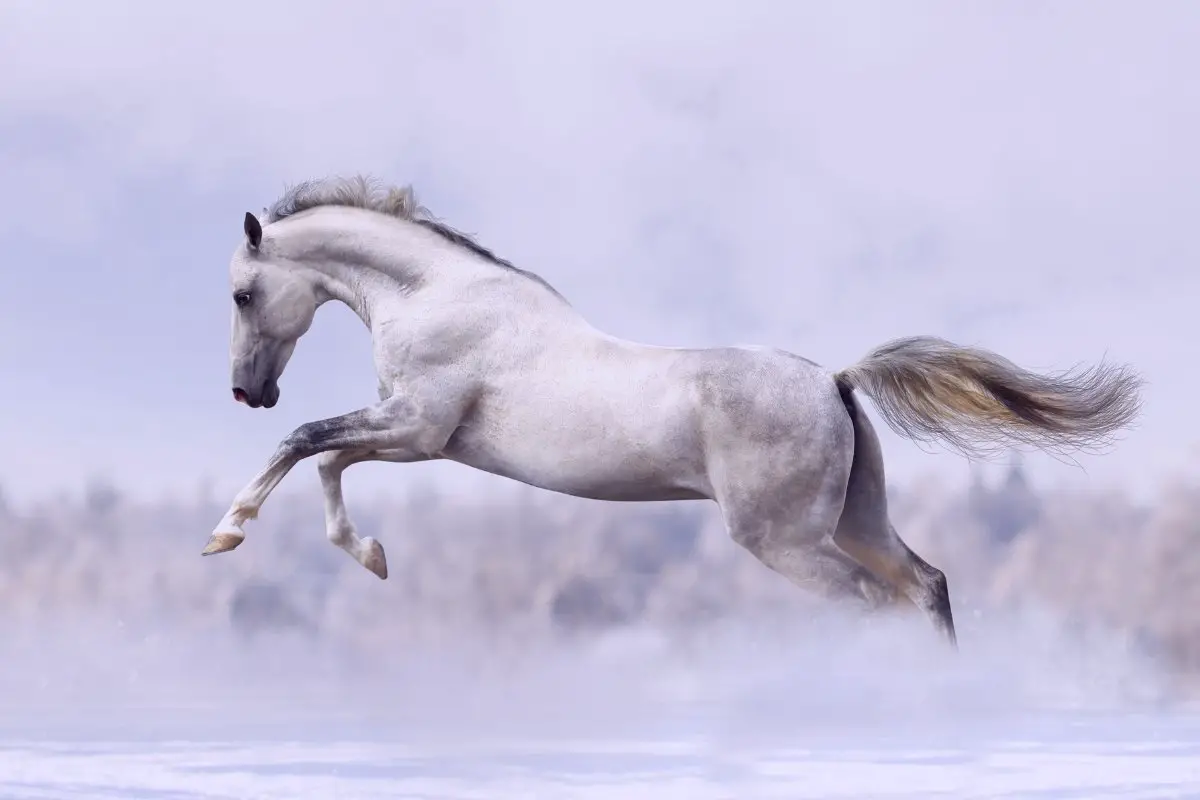Last Updated on February 14, 2022
Horses with unusual coat colors are highly sought after, with many people dreaming of owning a beautiful champagne gold or gleaming silver horse. But is there a silver gene in horses, and how do we get these unusual colors?
How Do Horses Get Their Coloring?
The world of equine color genetics is a fascinating topic, and to know if there is a silver gene in horses we first need to understand how a horse gets its coloring.
Every horse is born with a pair of genes that determines its base coat color. It inherits one of these from its dam, and the other from the sire. There are only two options for this base color gene – red or black.
So, the horse could inherit one of three possible combinations. It could have two black genes, which gives a black base coat color. It could have two red genes, which gives us a chestnut or sorrel. And finally, it could have one of each, which is where bay horse coloring comes from.

This means that all horses start off either black, bay, or chestnut. It is only when other genetic modifiers come on the scene that things start to change!
There are many different types of color-modifying genes. The horse might inherit one of the white spotting genes, that give the many different types of pinto coloring. It may also inherit genes that create roan coloring, or a gene that turns the entire coat grey.
And finally, we have a group of color modifying genes called dilution genes. These lighten the color of the horse’s coat, and each one acts slightly differently. It is these that give us the myriad of beautiful shades such as palomino, cremello, and buckskin.
Check Out What Is A Grey Sabino Horse Color?
Is There A Silver Gene In Horses?
The types of dilution genes that horses can inherit include:
- Dun
- Cream
- Silver
- Champagne
- Pearl
- Mushroom
- Light Black
So, yes, there is a silver gene in horses! This is often referred to as the silver dapple gene, and it has a beautiful effect on the color of the horses’ coat.
The silver gene does not exactly turn the horse silver, but it acts in an unusual way that varies according to the base coat color of the horse.
If a horse with a black base coat color inherits the silver dapple dilution gene, the mane and tail of the horse will be lightened to a silvery grey color. The coat hairs will be dark grey-brown, often with distinctive dappled spots of silver hairs.
A bay horse with the silver dapple gene will have a chocolate-red body color, and a dark silver mane and tail. The legs will be silver-brown, and you may also see silvering around the eyes and nose. These are sometimes called silver red horses.
The silver gene has no effect on chestnut hairs, and horses with a chestnut base coat will not be altered by this gene. This is because the silver dapple dilution gene only changes the color of black-pigmented hair, and has no effect on red (chestnut) hair. However, they can still carry the gene and potentially pass it on to any offspring.
Click Here to Learn:
How Do You Get A Silver Horse Color?
Horses with silver dapple coloring are highly sought after, and the best way to maximize the chances of a silver foal is to carry out genetic testing of the dam and sire. This means that you can breed from parents that have a high likelihood of passing on the silver dam dilution gene.
To do this, you need to select a breeding stock that carries two copies of the silver dilution gene. This will give you a 100% chance that the foal will be born with silver dappled coloring. However, you also need to minimize the chances of a chestnut foal, as these do not show any color change even if they carry the silver gene.
Unfortunately, horses with two copies of the silver dilution gene are also more likely to breed foals that inherit an eye disorder known as Multiple Congenital Ocular Anomalies (MCOA). Therefore is it is not advisable to breed from these horses, but instead to select breeding stock with just one copy of the silver dilution gene. This reduces the chance of producing a silver foal to 50%, but also means that the offspring will have a milder form of MCOA.
In its most severe form, MCOA can cause abnormalities of the cornea and retina of the eye, leading to impaired vision. In its milder form, cysts can develop within the eye, but the vision is largely unaffected.
Read more about Overo Horse Color Explained!
Is There A Silver Horse Breed?
Like all coat modification genes, some breeds and types of horse are much more likely to carry them, while other bloodlines do not have them at all.
Many horse breeds with Scandinavian origins are associated with silver dapple coat coloring. These include the Icelandic Horse, Shetland Pony, Nordland Pony, Swedish Warmblood, and the Welsh Mountain Pony.
In the US, breeds that carry the silver dapple gene include the Rocky Mountain Horse, the Miniature Horse, American Quarter horse, Tennessee Walking Horse, and the Missouri Foxtrotter.
Other European bloodlines with the silver dapple gene are the draft breeds Ardennes and Comtois.

You may also hear silver dapple horses referred to as taffy or chocolate-colored, particularly when on a bay base coat. This coloring is easily confused with a dark palomino or flaxen chestnut,
Summary
So, as we have learned, there is a silver gene in horses that will dilute black hairs to a silver-grey color. This gene will give a black horse an almost white mane and tail, and a dappled dark grey body. Bay horses will retain a reddish tinge to their coat, with a silver mane and tail. Chestnut coat coloring is not affected by the silver gene in horses.
We’d love to hear your thoughts about horses with silver coats! Have you ever seen a black horse with silver patterning in real life? Or perhaps you’ve always dreamed of owning one of these beautiful horses? Leave a comment below and we’ll get back to you!

Kate Chalmers is a qualified veterinary nurse who has specialized in horse care for the vast majority of her career. She has been around horses since she was a child, starting out riding ponies and helping out at the local stables before going on to college to study Horse Care & Management. She has backed and trained many horses during her lifetime and competed in various equestrian sports at different levels.
After Kate qualified as a veterinary nurse, she provided nursing care to the patients of a large equine veterinary hospital for many years. She then went on to teach horse care and veterinary nursing at one of the top colleges in the country. This has led to an in-depth knowledge of the care needs of horses and their various medical ailments, as well as a life-long passion for educating horse owners on how to provide the best possible care for their four-legged friends.
Kate Chalmers BSc (Hons) CVN, Dip AVN (Equine) Dip HE CVN EVN VN A1 PGCE


